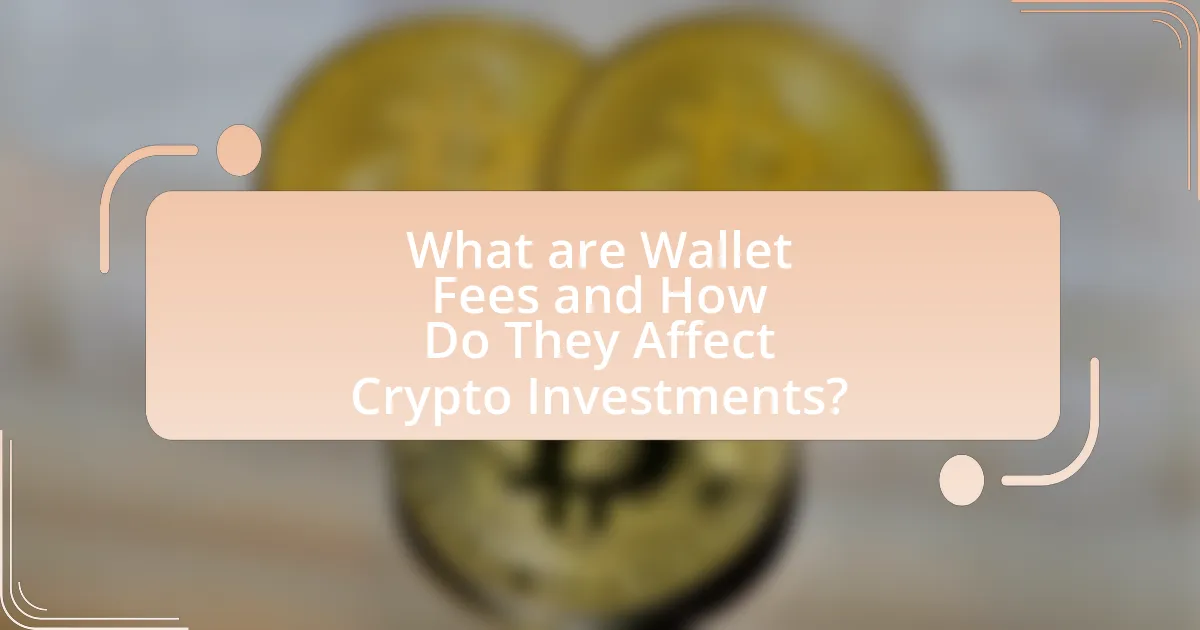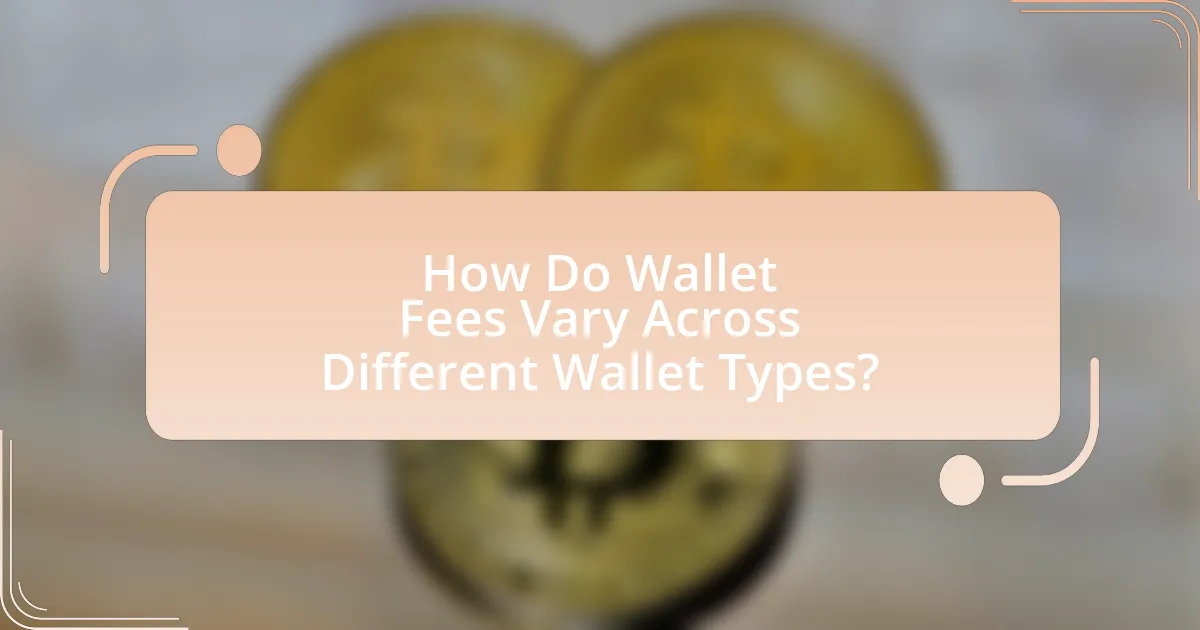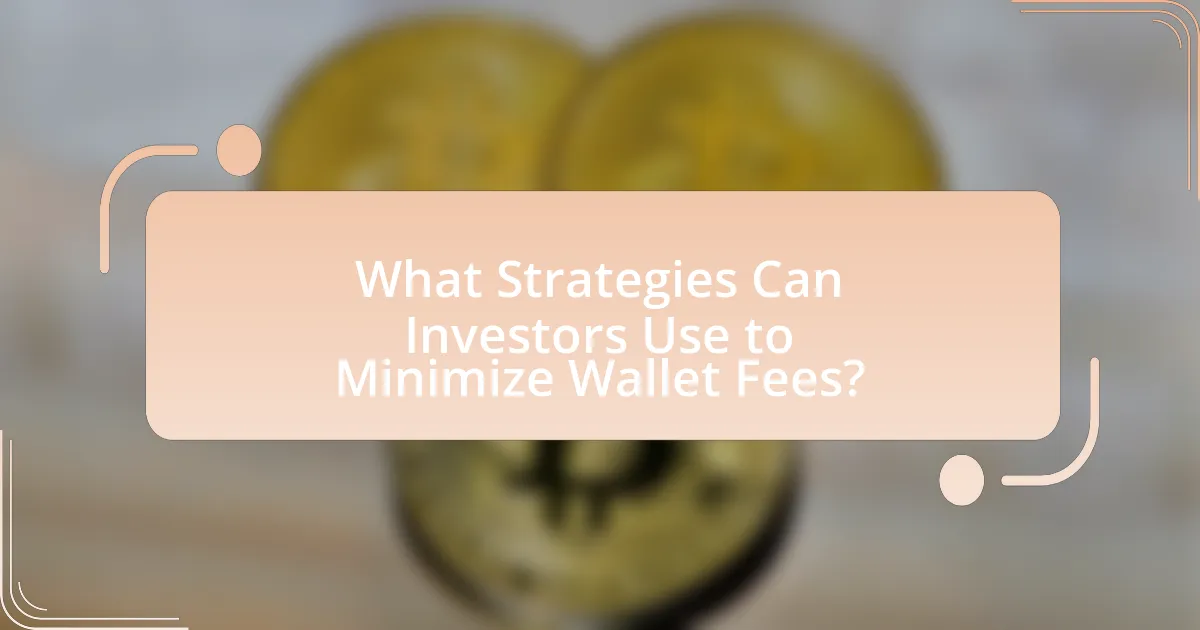Wallet fees are charges associated with using cryptocurrency wallets for storing, sending, or receiving digital assets, and they can significantly affect investment returns. This article explores various types of wallet fees, including transaction, withdrawal, and maintenance fees, and their implications on the overall cost of investing in cryptocurrencies. It also examines the differences between custodial and non-custodial wallet fees, the impact of transaction fees on trading profitability, and strategies investors can employ to minimize these costs. Additionally, the article highlights the importance of understanding fee structures across different wallet types, including hardware and mobile wallets, and offers best practices for managing wallet fees effectively.

What are Wallet Fees and How Do They Affect Crypto Investments?
Wallet fees are charges incurred when using cryptocurrency wallets to store, send, or receive digital assets. These fees can significantly impact crypto investments by reducing the overall returns on transactions and affecting the cost of trading. For instance, high wallet fees can deter frequent trading, leading investors to miss out on potential market opportunities. Additionally, according to a report by the Cambridge Centre for Alternative Finance, transaction fees can vary widely among different wallets and networks, influencing the choice of wallet and overall investment strategy. Thus, understanding wallet fees is crucial for optimizing investment outcomes in the cryptocurrency market.
What types of wallet fees exist in the cryptocurrency ecosystem?
In the cryptocurrency ecosystem, there are several types of wallet fees, including transaction fees, withdrawal fees, and maintenance fees. Transaction fees are charged when sending or receiving cryptocurrencies and can vary based on network congestion; for example, Bitcoin transaction fees can fluctuate significantly depending on the number of transactions being processed at any given time. Withdrawal fees are incurred when transferring funds from a wallet to an exchange or another wallet, and these fees can differ based on the wallet provider’s policies. Maintenance fees may apply to certain wallets that require a subscription or charge for ongoing services, such as enhanced security features or customer support. These fees can impact overall investment returns, as they reduce the net amount of cryptocurrency available for trading or holding.
How do transaction fees impact the overall cost of investing in crypto?
Transaction fees significantly increase the overall cost of investing in cryptocurrency by reducing the net returns on investments. When investors buy or sell cryptocurrencies, they incur transaction fees that can range from a fraction of a percent to several percent, depending on the network congestion and the specific cryptocurrency. For example, during peak times, Bitcoin transaction fees have reached over $60, which can substantially diminish the profitability of a trade. Additionally, frequent trading can lead to cumulative fees that further erode investment gains, making it crucial for investors to factor these costs into their investment strategies.
What are the differences between custodial and non-custodial wallet fees?
Custodial wallet fees typically include account maintenance fees, withdrawal fees, and transaction fees charged by the service provider, while non-custodial wallets generally do not impose such fees, as users retain full control over their funds. Custodial wallets, managed by third-party services, often charge fees for the convenience of managing private keys and providing additional services, which can vary widely among providers. In contrast, non-custodial wallets allow users to manage their own private keys, resulting in fewer or no fees, although users may still incur network transaction fees when sending or receiving cryptocurrencies. This distinction is crucial for investors, as custodial fees can impact overall investment returns, while non-custodial options may offer greater cost efficiency and control over assets.
Why are wallet fees important for crypto investors?
Wallet fees are important for crypto investors because they directly affect the overall cost of transactions and the profitability of investments. High wallet fees can reduce the net gains from trading or transferring cryptocurrencies, making it essential for investors to consider these costs when choosing a wallet. For instance, during periods of network congestion, transaction fees can spike significantly, impacting the timing and execution of trades. According to data from the Bitcoin network, average transaction fees can vary widely, sometimes exceeding $50 during peak times, which illustrates the financial impact on investors. Therefore, understanding wallet fees helps investors make informed decisions that can enhance their investment returns.
How can wallet fees influence investment decisions?
Wallet fees can significantly influence investment decisions by affecting the overall cost of transactions and the net returns on investments. High wallet fees may deter investors from making frequent trades or moving assets, leading to a more static investment strategy. For instance, if a wallet charges a fee of 1% per transaction, an investor making multiple trades could see a substantial reduction in their profits over time, especially in a volatile market where quick trades are essential for capitalizing on price movements. Additionally, research indicates that investors are more likely to choose wallets with lower fees, as these options can enhance profitability and encourage more active trading behaviors.
What role do wallet fees play in the profitability of crypto trading?
Wallet fees significantly impact the profitability of crypto trading by directly reducing the net gains from transactions. When traders incur fees for transferring assets to and from wallets, these costs diminish the overall profit margin, especially in high-frequency trading scenarios where multiple transactions occur. For instance, if a trader makes a profit of $100 but pays $10 in wallet fees, the effective profit is only $90. This relationship highlights the importance of considering wallet fees in trading strategies, as they can erode profits over time, particularly in volatile markets where margins are already thin.

How Do Wallet Fees Vary Across Different Wallet Types?
Wallet fees vary significantly across different wallet types, primarily categorized into hardware wallets, software wallets, and custodial wallets. Hardware wallets typically charge a one-time purchase fee and may have minimal transaction fees, while software wallets often have lower or no upfront costs but may impose transaction fees based on network activity. Custodial wallets, managed by third parties, may charge ongoing fees for services, including withdrawal and transaction fees, which can fluctuate based on the provider’s policies. For instance, a study by the Cambridge Centre for Alternative Finance indicates that custodial wallets can have fees ranging from 0.5% to 2% per transaction, depending on the service level and transaction volume.
What are the fee structures for hardware wallets?
Hardware wallets typically have a one-time purchase fee ranging from $50 to $200, depending on the brand and model. Additionally, some hardware wallets may charge transaction fees for sending or receiving cryptocurrencies, which are usually determined by the network and not the wallet itself. For example, Bitcoin transactions can incur fees based on network congestion, while Ethereum transactions may vary depending on gas prices. These fees are essential to consider as they can impact the overall cost of managing crypto investments.
How do hardware wallet fees compare to software wallet fees?
Hardware wallet fees are generally higher than software wallet fees. Hardware wallets typically involve a one-time purchase cost ranging from $50 to $200, while software wallets are often free to download and use, with fees primarily associated with transaction costs. For example, a study by the Cambridge Centre for Alternative Finance indicates that hardware wallets incur upfront costs, whereas software wallets may only charge network fees for transactions. This cost structure highlights that while hardware wallets offer enhanced security, they come with higher initial expenses compared to the more accessible software wallets.
What factors contribute to the cost of using a hardware wallet?
The cost of using a hardware wallet is influenced by several factors, including the initial purchase price, security features, brand reputation, and ongoing maintenance costs. The initial purchase price varies widely, typically ranging from $50 to $200, depending on the model and manufacturer. Security features, such as biometric authentication and secure chip technology, can increase costs but provide enhanced protection for digital assets. Brand reputation also plays a role, as well-known brands may charge a premium due to their established trust and reliability in the market. Additionally, ongoing maintenance costs, such as firmware updates and potential replacement parts, can contribute to the overall expense of using a hardware wallet.
What are the implications of using mobile wallets regarding fees?
Using mobile wallets can lead to various fee implications, including transaction fees, service fees, and potential hidden costs. Transaction fees are often charged for sending or receiving funds, which can vary based on the network congestion and the wallet provider’s policies. Service fees may apply for specific features, such as currency conversion or premium services. Additionally, some mobile wallets may impose hidden fees, such as withdrawal fees or inactivity fees, which can affect overall investment returns. For instance, a study by the Cambridge Centre for Alternative Finance found that transaction fees can significantly impact the profitability of crypto investments, especially during high volatility periods.
How do mobile wallet fees affect small-scale transactions?
Mobile wallet fees significantly impact small-scale transactions by increasing the overall cost of these transactions, which can deter users from utilizing mobile wallets for minor purchases. For instance, if a mobile wallet charges a fee of 2% on a $10 transaction, the fee amounts to $0.20, making the effective cost of the transaction $10.20. This percentage can disproportionately affect small transactions compared to larger ones, where the fee becomes a smaller fraction of the total amount. Research indicates that high transaction fees can lead to reduced usage of mobile wallets for low-value transactions, as consumers may seek alternative payment methods that incur lower costs.
What should users consider when choosing a mobile wallet based on fees?
Users should consider the types of fees associated with a mobile wallet, including transaction fees, withdrawal fees, and any monthly or annual maintenance fees. Transaction fees can vary significantly between wallets, impacting the overall cost of sending or receiving funds. For instance, some wallets charge a flat fee per transaction, while others may take a percentage of the transaction amount. Additionally, users should evaluate withdrawal fees, which can affect the cost of transferring funds to a bank account or another wallet. Maintenance fees, although less common, can also add to the total cost of using a wallet over time. Understanding these fee structures allows users to select a wallet that minimizes costs and maximizes their investment returns.

What Strategies Can Investors Use to Minimize Wallet Fees?
Investors can minimize wallet fees by selecting wallets with lower transaction fees, utilizing batch transactions, and opting for off-peak transaction times. Choosing wallets that offer competitive fee structures, such as those that allow users to set their own fees, can significantly reduce costs. For instance, some wallets charge fees based on network congestion, so conducting transactions during times of lower activity can lead to reduced fees. Additionally, batch transactions, which involve sending multiple transactions in one go, can consolidate fees and lower overall costs. These strategies are effective as they directly address the factors influencing wallet fees, allowing investors to optimize their expenses in cryptocurrency transactions.
How can investors choose wallets with lower fees?
Investors can choose wallets with lower fees by comparing the fee structures of different wallets before making a selection. Many wallets charge varying fees for transactions, withdrawals, and conversions, so reviewing these details on their official websites or user reviews can provide clarity. For instance, some wallets may offer zero fees for certain transactions or have lower fees for specific cryptocurrencies, which can significantly reduce overall costs. Additionally, utilizing fee comparison tools or platforms that aggregate wallet information can help investors identify the most cost-effective options available in the market.
What features should investors look for in a wallet to reduce fees?
Investors should look for wallets that offer low transaction fees, support for multiple cryptocurrencies, and features like fee customization. Low transaction fees directly reduce the cost of transferring assets, while support for multiple cryptocurrencies allows investors to manage various assets in one place, potentially minimizing the need for multiple transactions across different wallets. Fee customization enables users to adjust fees based on urgency, allowing them to choose lower fees during non-peak times. According to a study by Chainalysis, wallets with these features can significantly lower overall transaction costs, enhancing the profitability of crypto investments.
How can timing transactions help in minimizing wallet fees?
Timing transactions can help minimize wallet fees by allowing users to execute trades during periods of lower network congestion. When the blockchain network is less busy, transaction fees typically decrease, as fewer users are competing to have their transactions processed. For example, during off-peak hours, such as late nights or weekends, fees can be significantly lower, sometimes by as much as 50% compared to peak times. This strategy is particularly effective in networks like Ethereum, where gas fees fluctuate based on demand. By monitoring network activity and choosing optimal times for transactions, users can effectively reduce their overall wallet fees.
What are some best practices for managing wallet fees effectively?
To manage wallet fees effectively, users should regularly compare transaction fees across different wallets and networks. This practice allows users to identify the most cost-effective options for their transactions, as fees can vary significantly depending on the wallet provider and the blockchain network used. Additionally, users can optimize their transaction timing by monitoring network congestion; fees tend to be lower during off-peak times. Implementing batch transactions can also reduce costs, as multiple transactions can be combined into one, minimizing the overall fee. Furthermore, selecting wallets that offer fee customization options enables users to set their preferred fee levels based on urgency and cost considerations. These strategies collectively help in minimizing wallet fees and maximizing the value of crypto investments.
How can investors track and analyze their wallet fees over time?
Investors can track and analyze their wallet fees over time by utilizing blockchain explorers, wallet management tools, and fee tracking applications. Blockchain explorers allow users to view transaction histories, including fees paid for each transaction, providing a transparent record of wallet activity. Wallet management tools often include built-in analytics features that summarize fees incurred over specific periods, enabling investors to assess trends. Additionally, fee tracking applications can aggregate data from multiple wallets, offering insights into overall fee expenditures and helping investors make informed decisions regarding their crypto investments.
What tools are available to help investors manage wallet fees?
Investors can utilize several tools to manage wallet fees effectively. Wallet fee calculators, such as those provided by websites like CoinMarketCap and CryptoCompare, allow users to estimate transaction costs based on current network conditions. Additionally, many cryptocurrency wallets, including Exodus and Trust Wallet, offer built-in fee management features that enable users to customize transaction fees according to their preferences. Furthermore, platforms like Binance and Coinbase provide insights into fee structures and allow users to choose between different withdrawal options, which can help minimize costs. These tools are essential for optimizing investment strategies and reducing unnecessary expenses associated with wallet transactions.
What common mistakes should investors avoid regarding wallet fees?
Investors should avoid underestimating wallet fees, as these costs can significantly impact overall investment returns. Many investors fail to account for transaction fees when transferring cryptocurrencies between wallets, which can lead to unexpected losses. For instance, a study by the Cambridge Centre for Alternative Finance indicates that transaction fees can vary widely, sometimes exceeding 5% of the transaction amount during peak network congestion. Additionally, investors often overlook the cumulative effect of frequent transactions, which can erode profits over time. By not comparing wallet options and their associated fees, investors may inadvertently choose wallets with higher costs, further diminishing their investment potential.